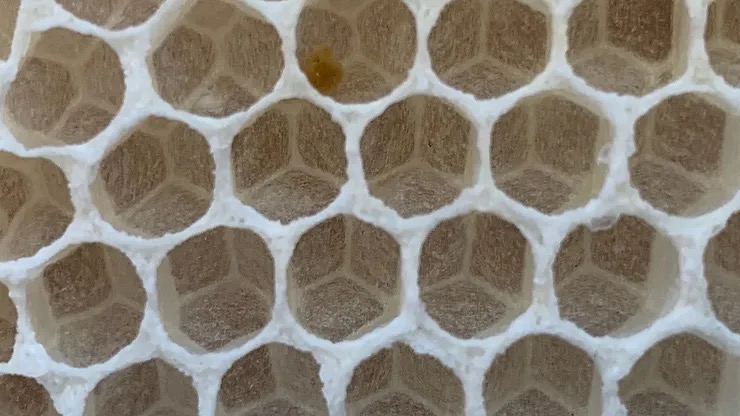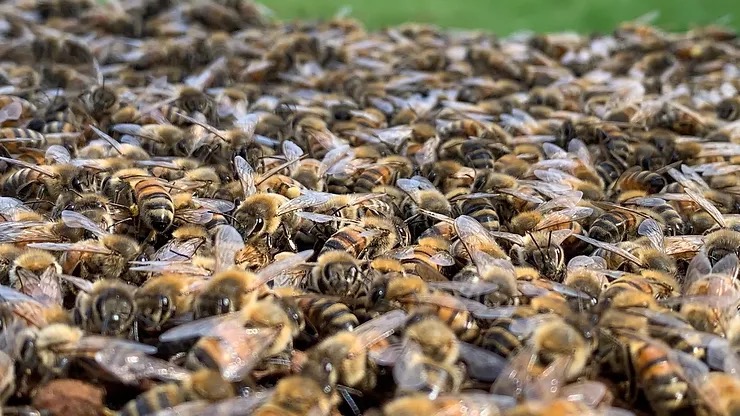Recently we’ve been talking to the local community about bees. It’s been a great opportunity to connect with those who are keen to know more about what makes bees fascinating. There’s a lot! It got us thinking about the different aspects of bees we’ve learned during the three seasons we’ve been beekeeping.
The first aspect relates to the different roles assumed by bees within the colony. Here are some of the jobs worker bees perform during their short lives* – all without being told what to do.
*around 6 weeks in the summer months.
Domestic staff
One of the first jobs carried out by a newly emerged worker bee is that of cleaner. Cells need to be cleaned and polished so they’re ready to be used again for the queen to lay eggs in.

Nursery nurse
Nurse bees look after and feed the young brood (larvae) until around day 9 when their cell is capped and they enter the pupa stage.
Queen attendants
The attendants feed and groom the queen. In doing so, they also help spread the queen’s pheromone throughout the hive. (The pheromone tells the rest of the colony that the queen is alive and well and doesn’t need replacing, thank you very much!)
Construction workers
Worker bees are expert builders, creating honeycomb from geometrically perfect hexagonal wax cells. The honeycomb structure is very efficient – it’s estimated that 1kg of wax can be used to store 40kg of honey! And not only do they build, they also produce the raw material itself – the wax is secreted from glands under their abdomens.

Security staff
Protecting the entrance to the hive, guard bees will defend it against other colonies attempting to rob honey, or wasps which will kill bees as well as stealing the honey.
Warehouse workers
Workers will act as receivers and packers – receiving nectar and pollen from foragers and storing it in the honeycomb cells.
Chemists
Nectar is around 80% water. To produce honey, the bees produce enzymes that break down the sugars in the nectar. The modified nectar is passed from bee to bee and then evaporated until the water content is reduced to 18%. At this point, the honey will keep indefinitely and can be safely sealed inside a cell.
HVAC engineers
Heating, ventilation and air conditioning is also part of the workers’ responsibilities. Worker bees generate heat by exercising their flight muscles to keep the core of the colony at 34-35 degrees Celsius. On warm summer days they may need to cool things down by evaporating water within the hive. And ventilation is provided by fanning their wings to generate a current of air.

Mortuary workers
Whilst bees will usually die away from the hive, sometimes there will be deaths inside the hive. In this situation it’s the mortuary workers that drag their dead brothers and sisters and eject them from the hive entrance.
Forager
The best known role is reserved for the older bees. Foraging is dangerous work so it takes place during the last few weeks of a worker bee’s life. Foragers collect pollen, nectar, water and propolis and carry it back to the hive.

Scout bees
During swarming it’s the job of the scouts to search for a new location for the swarm to settle in. They indicate the location to the swarm (which is usually hanging in a tree) by performing a waggle dance on the surface of the cluster. Others will then go and check it out, and if they like what they find will repeat the dance. So the choice of location is a democratic process – with the colony moving off only when there is a critical level of agreement!
There are probably more which we haven’t learned about yet. Bees will change their roles to adapt to the needs of the colony and what is required of them. There isn’t an individual CEO bee running the show, rather it’s a collective intelligence… they all know what needs to be done and just get on with it!
